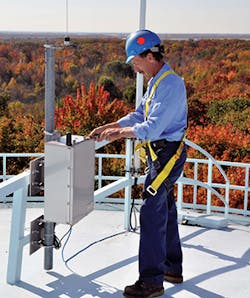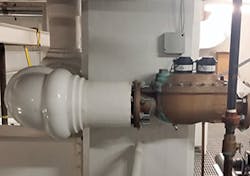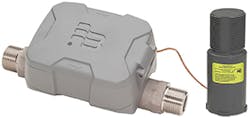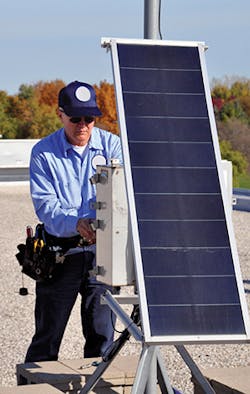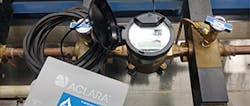The implementation of AMR/AMI has grown consistently by more than 20% annually among water utilities nationwide. However, no matter how outdated a metering system may be, changing to something new and different can be a difficult adjustment for utility companies and customers alike.
With so many options available, just making the decision can be a challenge. But, as infrastructure deteriorates and meters age, more utilities are taking advantage of the situation to migrate to newer technology for improved efficiency.
KANSAS CITY DOES THE WAVE
Until it launched a pilot project in May 2007, the average age of meters managed by KC Water was 18–20 years, with sample tests indicating that many of them were running at only 92%.
Problems weren’t limited to the equipment. Despite 42 employees performing meter readings, 25% of the readings were estimated. “We had a lot of turnover,” says Rob Thiemann, project manager with KC Water, “and there were no reads when it snowed.”
Having fallen behind on meter replacement, the utility decided to make a dramatic change by replacing its old, inefficient manual-reading system with an automated meter reading system. “It was an easy business case to make,” recalls Thiemann. “It was the right time to do it.”
It was really a customer service project, he insists. Prior to the migration, more than 50% of all customer calls were about meter readings and 70% of customer service fieldwork orders were meter-reading related. The old system was “terrible for customer support,” says Thiemann. He reports 30-minute wait times, with 35% of customers hanging up before they reached a person. “We had a lot of trouble with the call center. Our customers were very unhappy.”
They weren’t the only ones. Costs at KC Water escalated. “People and vehicles are expensive,” explains Thiemann. In addition, they had a “liberal policy” about leak adjustments, writing off excessive bills as bad debts. The situation had gotten out of control.
After visiting other cities such as Cincinnati and Washington DC to examine their systems, KC Water looked at mobile and fixed systems. “The mobile was less expensive up front,” states Thiemann, “but the life cycle cost of the fixed was better—and it provides extra data.”
Their request for information included a lifecycle model that accounted for the upfront cost, as well as aspects such as four reads per day and battery warranties. After comparing proposals and considering intangibles such as minority participation, they selected VSI, who chose Aclara as the sub-contractor providing the meters.
Aclara offers a variety of metering solutions.
The investment of $35 million for a fixed system with 165,000 end points has a projected payback period of seven years. Financing was achieved through a subordinated lease instead of a bond in order to bypass hurdles.
Between 2005 and 2008, approximately 50,000 meters per year were installed. Approximately 75% of the older meters were replaced; the remaining 25% of the meters that are compatible with the new WAVE system were not.
Installation posed some challenges because 60% of the meters were inside basements. “To install [the new ones], we had to go into 100,000 homes,” says Thiemann. It wasn’t always easy. There were access issues with a lot of properties. “We had to get tough with about 6,000 customers; we turned off the water if people didn’t let us in.”
Now, instead of one read every two months, the utility gets four reads a day. “It’s more accurate. We found lost water.” The WAVE (wireless, automatic, visionary, efficient) system is extremely accurate and measures to a 1 cubic-foot increment (approximately 7.5 gallons).
Meters are connected to a Meter Transmitter Unit that sends a radio signal to one of approximately 170 Data Collection Units (DCU) located in each geographic area. The DCUs then send those meter readings to the WAVE control computer, where they will be used for billing and customer service.
By collecting scheduled meter reads for timely and accurate billing, KC Water has increased revenue and reduced non-revenue water. Eliminating estimated reads has also eliminated many customer service problems and costs. “Customer surveys show they’re happier,” indicates Thiemann.
Some have seen an increase in their bills due to more accurate usage measurement, but the ability to view and track the consumption enables them to make changes in their usage that could lower their bill.
Thiemann is also pleased about the resultant accountability and better water management. As meters age, they tend to run more slowly and, therefore, do not accurately measure the water going through them. The new system, which has a lifecycle of 15 years, not only reads more accurately, but also sends an automatic e-mail alert when consumption increases.
Since installation, KC Water has recorded a 30–40% decline in water use. “We’re in the business to sell water, but if we don’t have to expand treatment because of usage reductions, it saves us money; 70% of our costs are fixed, so that’s something we monitor.” Incorporating an AMR system helped KC Water cut costs by reducing the number of meter readers as well.
While KC Water visited other cities prior to implementation in order to gather ideas and information, Thiemann says they, in turn, were visited by four to five utilities during deployment that sought to use them as a benchmark for their own projects.
NEW METERS IN THE OLD SOUTH
Etowah Water and Sewer Authority in Dawsonville, GA, wasn’t one of the visiting observers, despite some similarities in circumstances. Like KC Water, the utility in rural north Georgia had an aging meter fleet, with meters that were 20 years old or older. The difference, however, was that their meters came from “every manufacturer imaginable,” according to Brooke Anderson, general manager of the Etowah Water and Sewer Authority.
The meters were no longer accurate. It was time for a change, and this time, the utility wanted the 5,000 accounts to have the same brand and type of meter. “We did a lot of research,” says Anderson. “We found three kinds: manual read, drive-by radio system [AMR], and AMI, which automatically reports readings. It quickly became clear that the future is AMI. It offers improved customer service, improved water conservation, and better registering of flow.”
During its analysis of AMI systems and manufacturers, Etowah identified one significant criterion as proven technology. “We’re investing in the future,” envisions Anderson. “We need a system that will grow, be more relevant, and provide more tools.”
They also needed a strong, robust system because the rolling hills and deep valley in Dawsonville is challenging topography for AMI. “Sensus guaranteed the best accuracy and the simplest infrastructure with the fewest number of towers—three versus 20 with other providers,” lists Anderson. “It wasn’t the cheapest, but it was the best solution.”
It may have been expensive initially, but Anderson estimates the payback period at five years: a quick return on investment. And because the Sensus iPERL meter has an “extraordinary range of measurement that accounts for more water” with readings every hour versus once a month, Etowah Water has been able to account for virtually all flow going through the meter.
That has led to a vast improvement in customer service. “The bill reflects actual usage,” says Anderson. If the customer has a question, customer service representatives “can look at usage to see why bills are higher and have an intelligent conversation about it.” Benefits include reports on any meter with continuous 24-hour flow that allow them to contact the customer about potential leaks.
A meter installation
The accuracy of the new meters allows the utility to plan resources. “Our goal is to conserve resources,” explains Anderson. “We need data to do that. There’s a tremendous amount of data with the iPERL.”
That data will be integrated into the utility’s master plan to determine consumption patterns on individual basis. “By installing master meters in zones, we can compare usage with individual meters to look for leakage,” elaborates Anderson.
It took 12 months to install the infrastructure and change out meters in 2012, but these days, Anderson says their customers are more aware of their usage and are making appropriate adjustments. “Customer service is what it’s all about. Educated, happy customers drive conservation.”
IT’S NOT JUST A DOOBIE BROTHERS SONG
Salisbury, NC, doesn’t have many water conservation issues, but as Jason Wilson, engineering manager for Salisbury Rowan Utilities, says, “We want to be good stewards. AMI will help; it’s a good management tool.”
Salisbury Rowan Utilities is the primary water and sewer provider in the county. Because the utility company had put off a meter change-out program for 10–15 years in anticipation of AMI/AMR, the average age of its meters is 17 years—and some are almost 50 yearsold. “We only changed meters if there was an issue,” admits Wilson. With change-out due at 14 years, he knew the utility was losing revenue. “We had diminishing returns from the older meters.”
Their data-gathering method was equally antiquated: they were still manually reading 22,000 meters every month. “There were four different types of meters and reading systems from three manufacturers,” remembers Wilson. “Two drive-by systems, a touch read manual…. It was a hodgepodge. And they weren’t in routes; they were randomly placed. It took 128 man-hours a month to read them.” That was in a good month. They’re not equipped to deal with snow. “It cripples us. We can’t read meters, so it puts us behind.” Because the billing period is longer, the bill is higher.
It was time for a change.
Salisbury Rowan Utilities decided that the town of China Grove was a good candidate for a large-scale pilot project, so in 2012 they issued a request for quotation to evaluate systems. “We had a long list of needs and wants,” says Wilson.
They chose Badger ultrasonic meters because they have no moving parts, but they do have a 20-year life cycle. Wilson says they also liked the Web-based Beacon advanced meter and analytics.
Badger E-Series Ultrasonic with cellular endpoint
They received approval to change out 20,000 meters in 24 months—over three fiscal years. In 2014 they changed out “around 1,800” 5/8-inch and 3/4-inch meters, installing Badger E Series meters in their place. It took 22 days to complete.
In 2015 they changed the large meters (1 inch and up).
The fixed network is a “migrate-able solution,” says Wilson, that takes only 12 man-hours a month to read (because there are still 64 manual meters). The operational efficiency achieved through reduced time to read meters is only one of the benefits.
“The information we’re getting is phenomenal,” enthuses Wilson. The utility conducted a “mini water audit” of China Grove by looking at accounts where the customer remained unchanged for 12 months. Twelve months of data indicate that 56% accounts showed increase in usage. “We’re metering more.”
In addition to hourly data, the new system provides leak and tamper alarms. In fact, Wilson says that’s the “flip side” of getting new meters. “We’re getting a lot of alarms for tampering and leaks,” he indicates. “It’s a transition.”
Being proactive about customer service includes letting them know about leaks, but also includes answering billing questions. With the new system, Wilson is convinced that “everyone is paying their fair share.”
Fortunately, some of the seven staff members who no longer needed to read meters have become mechanics and technicians, dealing with the alarms.
The overall savings on staff has helped offset the service fee paid to Badger per end point.
Extrapolating the total savings achieved on the pilot project, Wilson estimates the payback period on the full-scale project at 8.7 years. Ultimately, though, there are even greater savings. “It costs tens of millions to upgrade a treatment plant. When you’re at 80% capacity, you need to design; at 90% capacity you need to expand. It’s a big step. It’s much cheaper to meter.”
As they continue to analyze the wealth of data from the pilot project, Salisbury Rowan Utilities is moving forward with plans for the full-system roll-out. Acknowledging the work that lies ahead, Wilson says they are excited about the future. Proper metering will allow the utility to be more sustainable. “We’ll have a smaller carbon footprint due to less driving, for one thing. Green technology is important. It’s hard to quantify, but there is an important social benefit.” In fact, he says they’re looking at renewable energy for their next wastewater plant. “We value our limited supply of water.”
KICKING AND SCREAMING
Neither Madison Water Utility (MWU) nor its customers initially wanted to change in 2010, but when the Wisconsin utility was informed that the Badger Read-o-Matic system it had been using since 1958 was about to become obsolete, change was inevitable.
“Our meters were still good,” recalls Robin Piper, customer service manager of the utility, who says they were on a 12- to 15-year change-out plan. Customers were billed twice a year, and because rates were reasonable, they didn’t want to change.
A rooftop installation supported by solar energy
Forced into an overdue upgrade, MWU hired a consultant, who wrote a white paper and a request for proposal. “We didn’t know what we were looking for,” explains Piper. “We knew we wanted monthly billing, but other than that, we wanted the marketplace to tell us what’s out there, what’s best.”
He says they opted to “skip” AMR because they considered it “’90s technology.”
Instead, they chose AMI: wireless transmission of water usage data. The three meter-reading technicians who used to visit every home and business twice a year to read the 65,000 old meters were retrained to service the new Badger meters.
It wasn’t a cheap project. Piper says the city budgeted it over two years, but because they only get one year at a time, a new mayor who wanted to cut costs by eliminating the second half of the budget put the project in danger. Ultimately, he was convinced of the necessity of completing the project so many didn’t want, and it moved forward accordingly, although not without additional challenges.
While MWU was happy with its decision, many of its customers were not. “They resisted,” states Piper simply. “They thought the RF [radio frequency] technology was unsafe.”
Their concern centered around radio frequency emissions. The AMI devices, which run on AA batteries, are generally installed in a home’s basement and emit low-level radio frequencies for a total of about 15 seconds per day.
One group of citizens filed a petition with the Public Service Commission to request cessation of the smart meter installations.
Madison Water Utility asked Public Health Madison Dane County (PHMDC) to examine the radio frequencies and create a report, which was released in mid-July 2012. Researchers found that the radio frequencies emitted are far lower than RFs from other common devices like laptops, cell phones, and microwaves. Finding little in the way of health risks, PHMDC supported the smart meter installations.
To appease those customers still resistant to the smart meters, MWU designed an opt-out plan. Customers could pay a one-time fee to have the new meter device installed outside their homes, or pay a monthly fee to opt-out of the new system altogether. According to Piper, 1,000 customers requested the smart meters be mounted on the outside and 470 (less than 1%) opted out entirely.
Once installation was completed, Piper says MWU began to appreciate the benefits of the new meters. Previously, because many readings were estimated due to twice-yearly readings, non-revenue water comprised about 8–11% of total water. “We track more closely now.”
Tracking allows them to catch leaks. “We run continuous use reports to establish a threshold,” explains Piper. He points out that some houses are vacant due to foreclosure or “snow birds” and that usage of 300 gallons per hour often indicates that the house has a serious leak.
Catching leaks increases revenue. Under the old system, MWU allowed “leak credits” for unintentional use of water, but with the new system, they discontinued that. The utility alerts customers to major residential leaks as early as three days after usage begins to spike.
In addition, customers are able to monitor their hourly usage online, so they are no longer given a credit. To date, Piper says 6,334 customers are viewing their usage and another 24,700 customers created accounts that would enable them to do so.
Another benefit of tracking usage is that the utility can “right-size” the meters based on hourly usage. This saves
the customer money because there is a base charge related to the size of the meter as well as a usage charge. “Customers are embracing the technology now,” says Piper. “They like having more tools and seeing their patterns of usage.”
They also like monthly billing, he says, which allows them to budget better than receiving a large bill every six months. Even with a rate increase last year, he says the monthly bill is not much higher.
The new system also saves MWU costs because they don’t have to pump and treat as much water. “We have a better understanding of flow,” observes Piper. They’ll save money later because their meters are on an extended 20-year change-out program.
Reporting few problems in 18 months of operation, Piper says MWU is still acclimating to the data and has plans to provide more information through automatic notifications and usage reports. The next planned phase is district metering. “We want to isolate 11 to 12 pressure zones in order to monitor water usage and check for leaks.
“We’re still growing into the fixed network system,” he continues. “You can only absorb so much at once! From two data points a year per customer to hourly readings is overwhelming.” But for a project no one planned or wanted, they’ve come a long way already and are currently living happily ever after.

